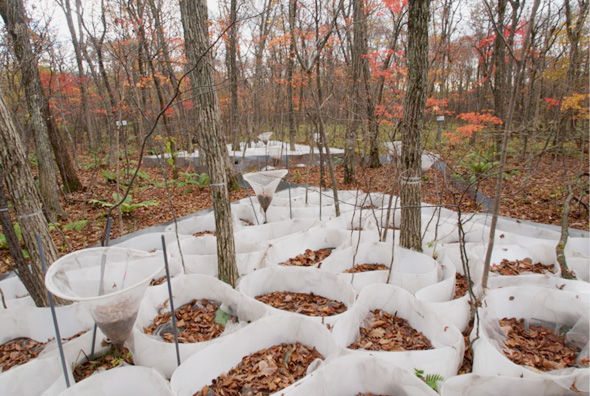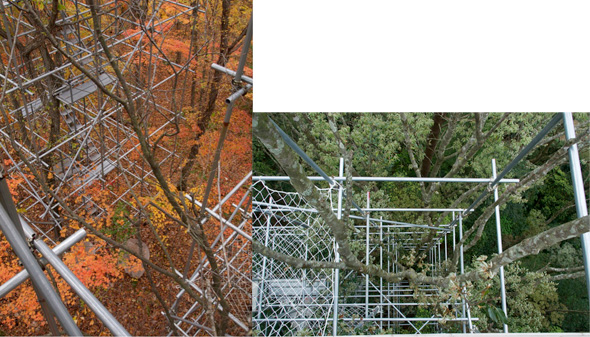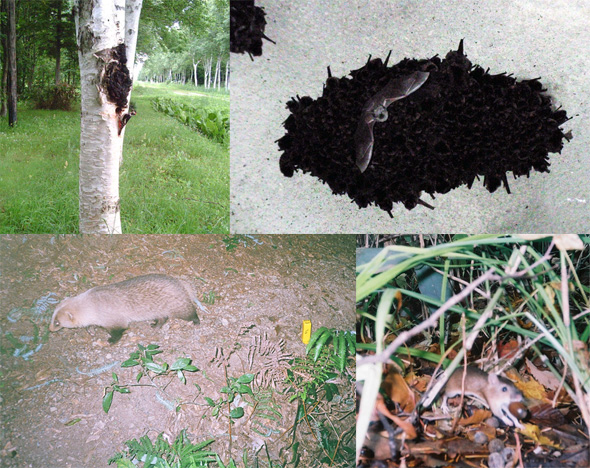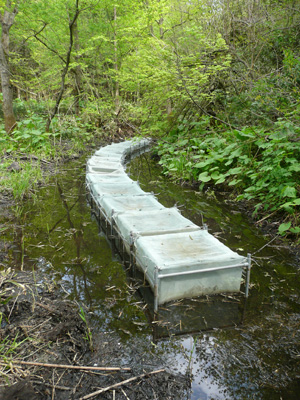Biodiversity Research
Explore the relationship between wild animals, plants, microbes, and the environment
We investigate the responses of biological interactions and communities to environmental change to clarify maintenance and change mechanisms of northern forest and wetland ecosystems. We apply a large variety of research techniques on the field (e.g. field experimental manipulations and long-term monitoring). We consider the whole experimental forest as a huge laboratory. Thus, we energetically conduct field experimental manipulations to get the direct evidence in the relationships between organisms and environments. For example, above- and under-ground parts of mature trees (20m in height) are warmed by electrically heated cables, and long-sequence fences are built to control deer density. Furthermore, we conduct geographical study for comparing forest ecosystem functions and continue for long-term observation on reproductive processes of trees and diversity of insects and fungus. Our research areas include community ecology, forest ecology, conservation ecology, mycology, and entomology.

The warming experiment of oak trees (Quercus crispula) using electrically heated cables: branch warming (left) and soil warming (right) of 20-m-high mature trees continue from 2007. We directly observe canopy leaves to measure herbivory by moth larvae, and photosynthesis and respiratory functions using canopy crane.

Litter fall manipulation to clarify the effect on the diversity of soil invertebrates.

Canopy access systems in deciduous (left) and evergreen forests (right) to investigate the functioning and biodiversity in forest canopies.
Wildlife ecology: the basic science for conservation
Our group studies ecology and conservation of wildlife. Main
study subjects are vertebrate animals such as mammals
including deer, fox, raccoon dog, raccoon, monkey, vole and bat,
and amphibians including salamander, toad and
frog. Through field work and experimental
study, we investigate
(1) role of wildlife in forest ecosystem,
(2) adaptive meaning and evolution of animal behavior
and life history,
(3) impacts of natural and artificial environmental changes on
animal behavior and population,
(4) population genetics of wildlife at large
spatial scales,
(5) intra- and inter-specific interactions,
and (6) population and community dynamics.
Study organisms
Animals including amphibians, birds and mammals are our main subjects.

Clockwise from top left, Great spotted woodpecker (Dendrocopos major) , Mixed colony of Eastern Bent-winged Bat (Miniopterus fuliginosus) and Japanese Large-footed Bat (Myotis macrodactylus), Large Japanese field mouse (Apodemus speciosus), Eurasian badger (Meles meles).
Animal survey using infrared camera
Using automotive infrared camera, we investigate distribution and behavior of mammals. Brown bears captured in Tomakomai Experimental Forest can be seen with the following video clips.
Brown bear cub (Ursus arctos)
Brown bear dam (Ursus arctos)
Field experiment
Our group conduct several field experimental projects.
 Field
experiment using enclosures to investigate ecological
interaction among aquatic creature.
Field
experiment using enclosures to investigate ecological
interaction among aquatic creature.
Example of study theme
As one of our researches, adaptive strategies in behavior and life history of animals are studied. For example, Rana pirica frog tadpoles plastically develop their body in the presence of predatory salamander larvae (Hynobius retardatus) to prevent them from being swallowed by the predator. We explore evolutionary processes and ecological consequences of the defensive strategy. Rana pirica tadpoles with non-defensive “typical” morph and with defensive “bulgy” morph can be seen with the following video clips.
Rana pirica tadpoles in a pond
without predatory salamander larvae. Tadpoles have typical
non-defensive morph.
Rana pirica tadpoles in a pond with
predatory salamander larvae. Tadpoles have defensive “bulgy”
morph.



